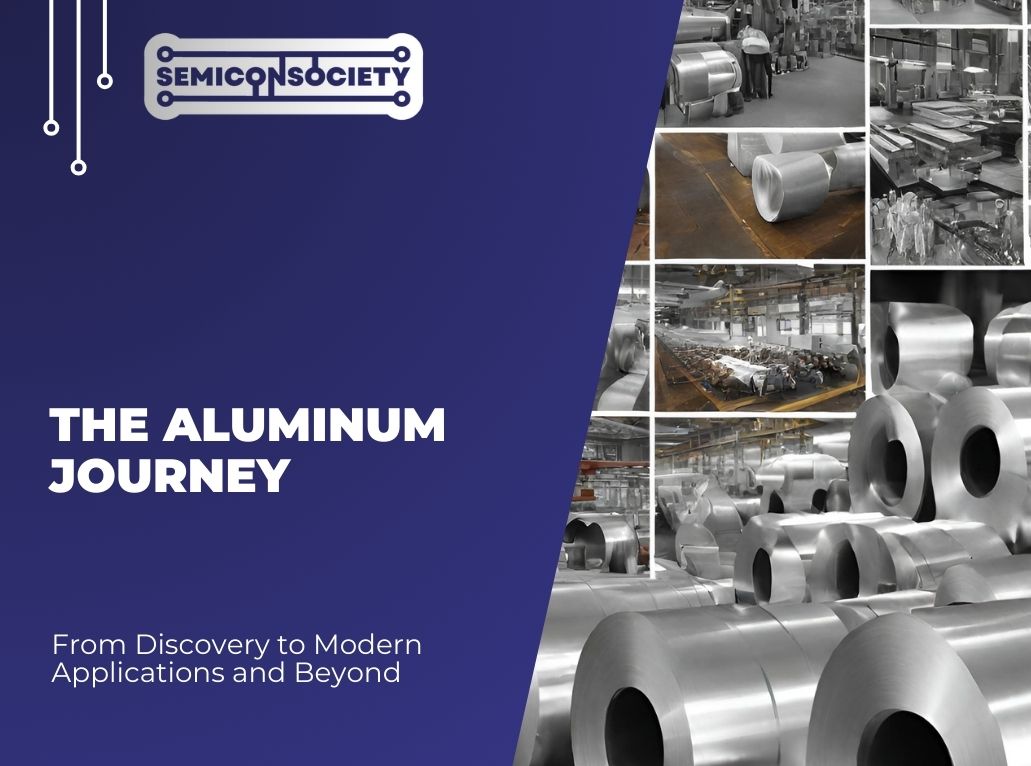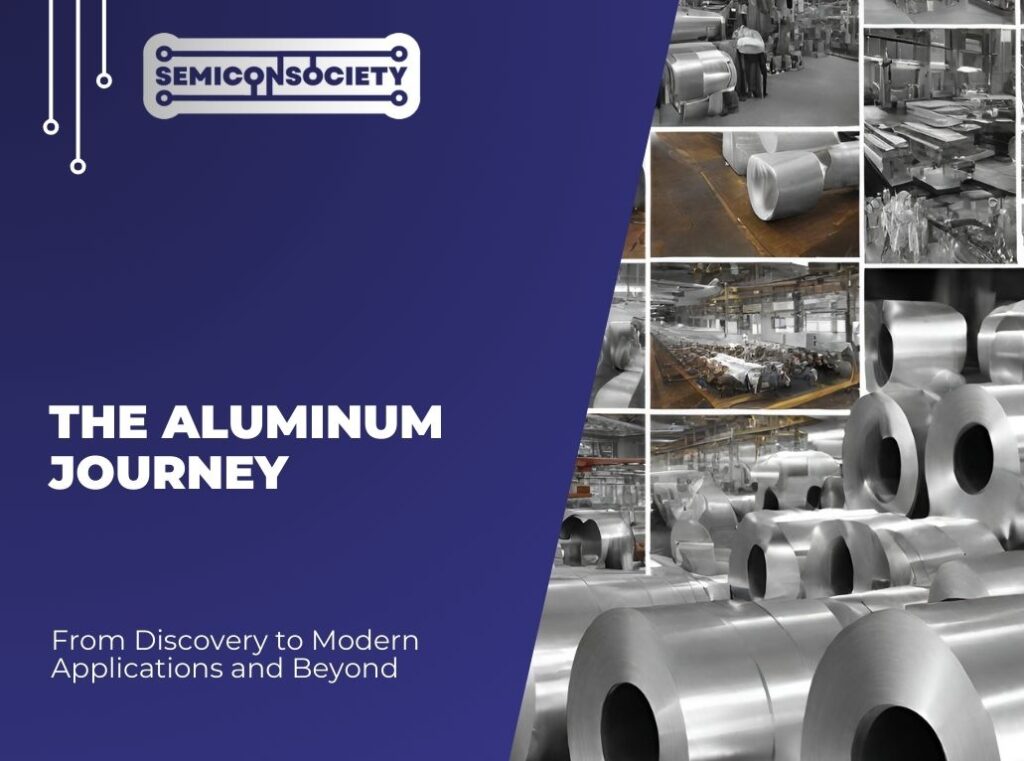Newsletter Subscribe
Enter your email address below and subscribe to our newsletter
Enter your email address below and subscribe to our newsletter


Aluminum is a versatile metal that has played a significant role in human history. From its discovery to its modern-day uses, aluminum has had a profound impact on industries and the environment.
In this article, we will explore the early history of aluminum, its industrial revolution, and production processes, as well as its modern applications. We will also discuss the environmental impact of aluminum production and look towards the future with new technologies and alternative uses.
Join us on this journey to uncover the fascinating world of aluminum.
Aluminum, also known as aluminium, is a versatile metal with atomic number 13. It is found in abundance in the Earth’s crust and has a diverse range of chemical properties.
Aluminum is one of the most common elements on Earth, making up about 8% of the Earth’s crust. Its atomic number, 13, indicates that it has 13 protons in its nucleus. This lightweight metal is highly prized for its corrosion resistance and excellent conductivity. Due to its malleability and ductility, aluminum is widely used in various industries, such as aerospace, construction, and packaging.
The early history of aluminum is marked by significant discoveries and inventions, with scientists like Charles Martin Hall, Paul Louis-Toussaint Héroult, and Humphry Davy playing pivotal roles.
Aluminum has a rich history that dates back to the 18th century when it was first recognized as a distinct element during the experiments of chemists and scientists. In the early 19th century, Sir Humphry Davy attempted to isolate aluminum but was unsuccessful due to the lack of proper techniques.
It wasn’t until the late 19th century that Hall and Héroult independently discovered an efficient method to extract aluminum through electrolysis, revolutionizing the metal industry. The isotopes of aluminum, particularly Aluminum-27, have played a crucial role in scientific research and medical applications.
The discovery of aluminum revolutionized the understanding of metals present in the Earth’s crust, attracting the attention of eminent scientists.
Aluminum holds a significant place in the periodic table due to its unique properties and widespread applications. Its discovery, credited to Friedrich Wöhler and others, marked a turning point in the study of elements. This lightweight metal, abundant in nature, challenged the conventional views on metal extraction and usage.
Aluminum isotopes revealed through research shed light on its diverse forms and behavior in different environments. Scientists continue to explore its versatility in industries ranging from aerospace to construction, showcasing its durability and versatility.
In its early days, aluminum was valued for its unique properties such as lightness, reflective quality, and its ability to be polished for making mirrors.
These qualities made it a sought-after material for various applications, from decorative objects to practical utensils. Its lightness enabled the creation of sturdy yet lightweight structures, revolutionizing industries like aerospace and construction. The reflective nature of aluminum made it perfect for producing high-quality mirrors, attracting artisans and craftsmen alike. Its polished surface not only enhanced its aesthetic appeal but also showcased its durability, encouraging further experimentation with its properties.
The Industrial Revolution marked a turning point in aluminum production, with innovations like the Bayer Process and contributions from Hall and Héroult revolutionizing the industry.
During this era, the demand for aluminum grew significantly, driving the need for more efficient extraction methods. The Bayer Process, introduced by Carl Josef Bayer in 1887, played a pivotal role by enabling the extraction of aluminum oxide from bauxite on a large scale.
Meanwhile, Charles Martin Hall and Paul Héroult independently developed the Hall-Héroult process, a revolutionary electrolytic method for producing aluminum. This breakthrough drastically reduced the cost of aluminum production, making the metal more accessible for various industries, from construction to transportation.
The invention of the Bayer Process revolutionized aluminum production by enabling the extraction of the metal from bauxite ore on a large scale.
Aluminum, a lightweight and versatile metal, is a key component in various industries ranging from aerospace to construction. The Bayer Process, developed by Carl Josef Bayer, plays a vital role in the production of aluminum due to its efficiency in extracting alumina from bauxite. The process involves dissolving bauxite in sodium hydroxide solution to precipitate out aluminum hydroxide, which is further processed to obtain pure aluminum oxide. This method significantly reduced the cost and complexity of aluminum extraction, paving the way for mass production and making aluminum more accessible for widespread use.
The mass production of aluminum gained momentum with the establishment of companies like Alcoa and the Pittsburgh Reduction Co., transforming the industry landscape in Europe.
Alcoa’s pioneering innovations in aluminum production processes revolutionized the industry, leading to increased efficiency and lower costs. Through strategic investments in technology and infrastructure, these companies were able to scale their operations and meet the growing demand for aluminum products worldwide.
Their influence extended beyond production, influencing market dynamics and setting new benchmarks for sustainability and corporate responsibility within the industry. As these giants expanded their reach and established a global presence, they played a crucial role in shaping the modern aluminum industry as we know it today.
In the modern era, aluminum finds extensive applications due to its exceptional strength, hardness, and its vital role in the aerospace industry through the creation of specialized alloys.
Aluminum’s versatility has made it a cornerstone material for various industries, from construction to automotive manufacturing. Its importance truly shines in the aerospace sector, where every ounce of weight saved can have a significant impact on performance and fuel efficiency. Engineers and researchers are constantly pushing the boundaries of aluminum alloy development to create lighter yet stronger materials that can withstand the extreme conditions of space travel.
The production of aluminum has a significant environmental impact, with concerns related to high energy consumption, waste generation, and pollution levels affecting the surrounding environment.
Aluminum production is known for its energy-intensive processes, with the extraction and refining of bauxite ore requiring substantial amounts of electricity. This heavy reliance on power sources contributes to greenhouse gas emissions, leading to air pollution and global warming consequences.
Managing the waste generated during aluminum production, such as red mud and toxic emissions, poses challenges in terms of storage, disposal, and environmental impact mitigation. These byproducts can contaminate soil and water sources, threatening ecosystems and biodiversity.
Energy consumption in aluminum production poses a critical environmental challenge due to the high energy requirements of extracting and refining the metal.
Given that aluminum smelting is an energy-intensive process, with electricity accounting for a significant portion of the production costs, the industry faces a dual challenge of cost-efficiency and sustainability. The carbon footprint associated with the energy-intensive production processes contributes to greenhouse gas emissions and climate change. In response to these challenges, the aluminum industry has been actively implementing energy-efficient technologies and practices to reduce its environmental impact. From adopting innovative smelting techniques to utilizing renewable energy sources, such as solar and hydroelectric power, the industry is striving to enhance its energy efficiency and sustainability measures.
The generation of waste and pollution from aluminum production processes presents significant environmental concerns, necessitating sustainable practices to mitigate negative impacts.
Aluminum production, although essential for various industries, contributes to environmental degradation through significant waste and pollution generation. The extraction and processing of aluminum ore result in emissions of greenhouse gases, harmful chemicals, and vast amounts of waste materials. These byproducts can contaminate water sources, harm wildlife, and contribute to air pollution.
Sustainability initiatives within the aluminum industry focus on reducing waste, improving energy efficiency, and utilizing recycling methods to lessen environmental impacts. Companies are increasingly investing in technologies to minimize waste generation and pollution, aiming to create a more sustainable future for aluminum production.
The future of aluminum holds promise with advancements in technology driving innovative production methods and expanding applications across various industries.
One of the key areas where aluminum is making a significant impact is in the automotive industry. Aluminum alloys are being used to create lighter but stronger vehicle components, leading to improved fuel efficiency and performance. The aerospace sector is also witnessing a surge in the use of aluminum due to its high strength-to-weight ratio and durability.
Advancements in recycling technology are enabling a more sustainable approach to aluminum production, reducing environmental impact and energy consumption. This shift towards eco-friendly practices is reshaping the industry and aligning with global sustainability goals.
New technologies are revolutionizing aluminum production by enhancing efficiency, sustainability, and expanding the scope of applications in diverse industries.
One of the key advancements is the utilization of AI-driven algorithms to optimize the production process, resulting in higher productivity and reduced energy consumption.
The integration of IoT devices allows real-time monitoring of operations, leading to better resource utilization and proactive maintenance.
The adoption of renewable energy sources like solar and wind power is reducing the environmental footprint of aluminum production, making it more sustainable.
Exploring alternative uses for aluminum showcases the versatility of the metal in innovative applications driven by advancements in technology and industry demands.
From aerospace to automotive industries, aluminum has demonstrated its capability to meet evolving needs with its lightweight properties and robust performance. Its corrosion resistance makes it a prime choice for construction projects, while its recyclability aligns with sustainable practices in manufacturing. In the medical field, aluminum plays a vital role in equipment design and implant production, highlighting its adaptability across diverse sectors. Whether in renewable energy solutions or consumer electronics, aluminum continues to pave the way for new possibilities and breakthrough innovations.
In conclusion, aluminum has left an indelible mark on history through its discovery, production innovations, and diverse applications, shaping industries and environmental considerations.
Historically, aluminum was once considered a precious metal and was more valuable than gold due to its rarity and difficulty in extraction. The industrial revolution in the 19th century marked a turning point with the development of efficient extraction methods, making aluminum more accessible and cost-effective. This led to a surge in production, especially with the Hall-Héroult process revolutionizing the aluminum smelting industry.
Today, the applications of aluminum are ubiquitous – from aerospace and automotive industries to construction, packaging, and even in everyday consumer products like electronics and furniture. Its lightweight nature, corrosion resistance, and recyclability make it a highly sought-after material in various sectors.https://www.youtube.com/embed/7zYmiSXRJis
The history of aluminum dates back to ancient times, with evidence of aluminum being used as early as 5000 BC in the form of a clay tablet found in modern-day Iraq.
Aluminum was first discovered in 1808 by Sir Humphry Davy, who isolated it as a metal through a process of electrolysis.
In the past, aluminum was primarily used for decorative purposes and as a luxury item due to its rarity. It was also used in small amounts in medicinal remedies and as a coloring agent for glass and ceramics.
It wasn’t until the late 19th century that aluminum became more widely available and affordable, thanks to advances in production processes.
In the early 20th century, aluminum played a major role in the aviation industry as it was lightweight and strong, making it an ideal material for aircraft construction. This led to a surge in demand and production of aluminum.
Today, aluminum is used in a wide range of industries, including transportation, construction, packaging, and electronics. It is also a vital component in many everyday items, such as cans, foil, and kitchen utensils.